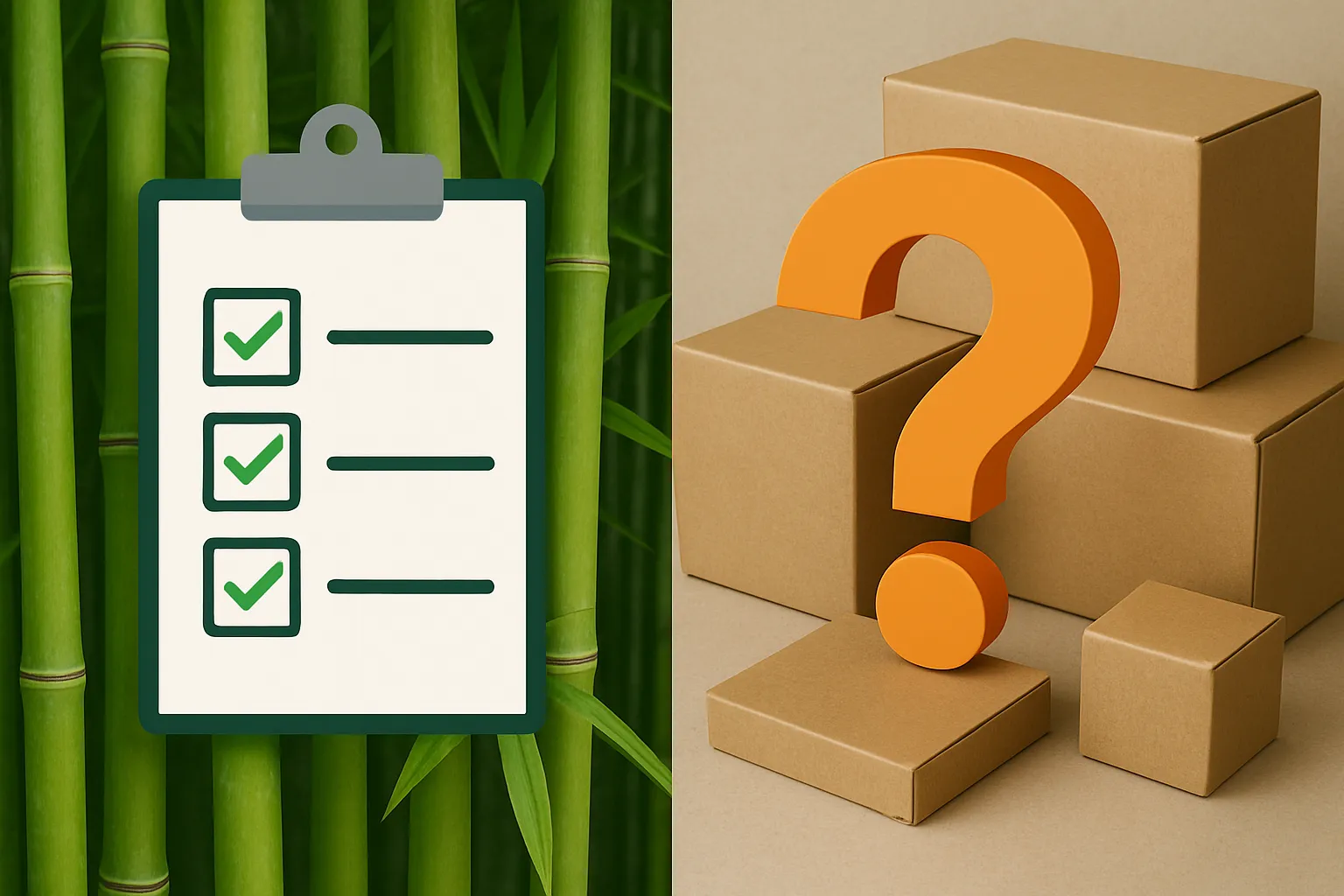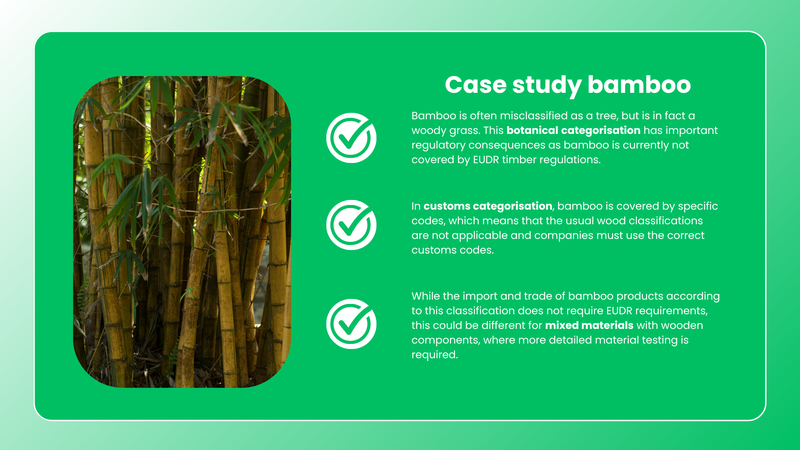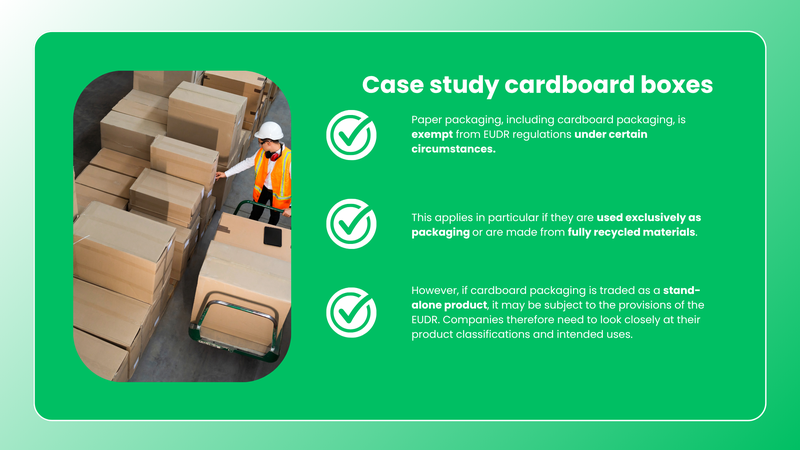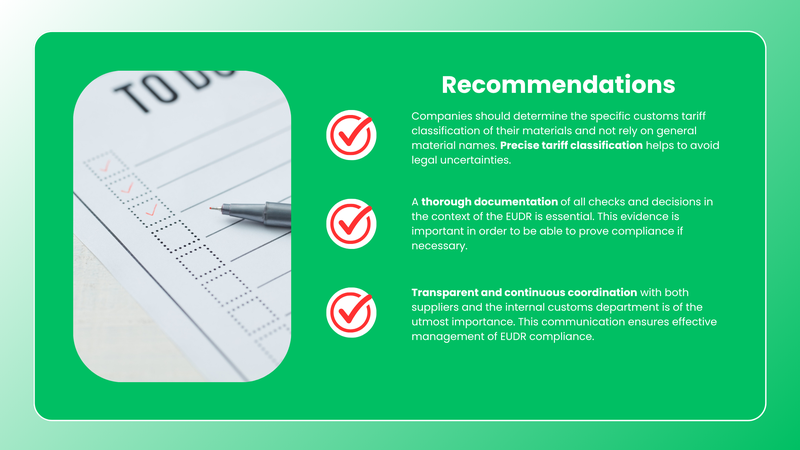Special cases for materials: Bamboo and cardboard packaging under the EUDR - What applies?
EUDR - Reading time: 8 Min

With the entry into force of the EU Deforestation Regulation (EUDR), the economy is facing a number of new challenges: Companies that import, market or export certain raw materials must fulfill strict due diligence obligations in order to prove that their products are not associated with deforestation or forest degradation. While the requirements for classic wood products or certain agricultural raw materials such as coffee and soy are comparatively clear, the specific application of the regulations in some special material cases creates uncertainty. Practical questions are increasingly arising, particularly when it comes to bamboo and cardboard or paper packaging: How are materials not explicitly mentioned to be classified? Which products are actually affected by the EUDR - and where do exceptions apply? The following article provides sound, practical guidance on the special cases of bamboo and cardboard packaging under the EUDR. It introduces the legal basis, explains the botanical and customs classification, sheds light on the legal gray area surrounding paper packaging and provides specific recommendations for companies. The article is therefore aimed at specialists and managers from compliance, purchasing, product management and supply chain management who are responsible for implementing the EUDR requirements - and who rely on clear, reliable classifications for materials such as bamboo or cardboard in their day-to-day business.
Important facts
The EUDR is a regulation that obliges companies to fulfill strict due diligence obligations to ensure that their products do not contribute to deforestation.
No, bamboo is a woody grass and not a tree. It is therefore not covered by the EUDR timber regulations.
Material mixtures of bamboo and wood are covered by the regulation.
Paper packaging is exempt from the EUDR if it only serves as packaging or is made from 100% recycled materials.
If they are traded as independent products, they may be affected.
Companies should check the exact tariff classification of their materials. Complete documentation of the checks is essential.
Precise classification of materials can reduce compliance costs and minimize liability risks.
Executive Summary
With the introduction of the EU Deforestation Regulation (EUDR), companies must follow strict due diligence requirements to ensure that their products do not contribute to deforestation. While the regulations for classic wood products are clear, materials such as bamboo and cardboard packaging raise questions that need to be clarified.
Bamboo case study
Bamboo is often incorrectly classified as a tree, but is in fact a woody grass. This botanical classification has important regulatory consequences, as bamboo is currently not covered by EUDR timber regulations. Companies working with bamboo can therefore exempt themselves from certain legal obligations. For tariff categorization, bamboo is covered by specific codes, which means that the usual timber classifications are not applicable and companies must use the correct customs codes. While the import and trade of bamboo products under this classification does not require EUDR requirements, mixed materials with wooden components may be different and require more detailed material testing.
Case study cardboard packaging
Paper packaging, including cardboard packaging, is exempt from the EUDR regulations under certain circumstances. This applies in particular if they are used exclusively as packaging or are made from fully recycled materials. However, if cardboard packaging is traded as a stand-alone product, it may be subject to EUDR regulations. Companies therefore need to look closely at their product classifications and uses to ensure that they do not unexpectedly fall under the EUDR.
Recommendations for companies
Companies should determine the specific tariff classification of their materials and not rely on generic material names. Precise tariff classification helps to avoid legal uncertainties and to apply the correct customs tariffs. Thorough documentation of all checks and decisions in the context of EUDR is essential. This evidence is important in order to be able to prove compliance if necessary. Transparent and continuous coordination with both suppliers and the internal customs department is of the utmost importance. This communication ensures effective management of EUDR compliance.
EUDR and the list of raw materials concerned - the framework
The central raw materials of the EUDR
The European Deforestation Regulation aims to reduce the risk of products made available in the EU being associated with global deforestation or forest degradation. The scope of the regulation is defined on the basis of a list of raw materials and their derivatives, which are explicitly listed in Annex I of the EUDR. The main raw materials include soy, beef, palm oil, coffee, cocoa, rubber and, above all, wood. Wood and its derivatives are of particular importance, as they play a fundamental role in numerous products and production processes.
The EUDR lists a large number of specific HS codes (Harmonized System, or CN headings for the customs tariff), which companies can use to check whether their goods are subject to declaration or documentation. For example, in addition to raw timber and construction timber, wood pulp, paper and paper products are also explicitly named with specific customs codes. The clear naming of these codes provides certainty - but what about products that cannot be clearly subsumed under these categories in practice?
How to deal with materials not explicitly mentioned?
Actual uncertainties arise for companies time and again when the materials used have wood-like properties or are similar in function to other raw materials, but are not explicitly mentioned in the Annex to the EUDR - or when their botanical or chemical origin is not clear. This is particularly relevant for substitute materials such as bamboo or composite materials, but also for classic secondary products such as cardboard. The question of whether such materials fall under the EUDR determines whether due diligence obligations, including verification, due diligence declarations and supply chain audits, must be fulfilled. Against this background, this article specifically analyzes the cases of bamboo and cardboard/paper packaging - two material groups that, for different reasons, regularly trigger the need for audits in business practice.
Case study 1: Bamboo - does it fall under the EUDR?

Botanical classification: Bamboo is not a tree
In order to enable the EUDR legal assessment of bamboo, a botanical clarification is first necessary. Botanically speaking, bamboo belongs to the sweet grass family (Poaceae). It is not a tree, but a woody grass that often reaches impressive sizes in tropical and subtropical regions and is of growing importance as a raw material in many branches of industry. Its ecological characteristic of growing quickly and taking up comparatively little space makes bamboo particularly attractive from a sustainability perspective and in bioeconomic cycles. Accordingly, bamboo is particularly in demand as a substitute for wood in areas such as furniture making, construction, packaging and consumer goods.
From a customs tariff perspective: Is bamboo treated like wood?
For the customs assessment, it is necessary to check under which HS heading bamboo and products made from it are classified. In fact, the EU customs tariff differentiates between "wood" (Chapter 44) and other woody plants. Bamboo is usually not part of the wood chapter, but runs under separate codes, for example "bamboo" under HS heading 1401 10. However, depending on the processing and product type, bamboo products can also appear in paper chapters or as finished goods under specific headings.
Although bamboo is sometimes referred to as "wood" due to its similarity to wood, customs law recognizes the botanical differentiation. Accordingly, bamboo is not a classic wood product in the strictest sense of the customs tariff. This tariff differentiation is particularly relevant with regard to the EUDR, as most obligations are explicitly linked to categories of wood defined under customs law.
Consequences for the EUDR
According to the FAO, bamboo is regarded as another forestry product and therefore does not fall under the raw material wood. The key message for companies is therefore: According to the current interpretation of the EUDR, bamboo, as a botanically and customs-wise independent group of raw materials, does not fall under the explicitly named wood raw materials or derivatives subject to EUDR. This applies both to raw bamboo material and to products made of bamboo (e.g. chopping boards, furniture, bamboo parquet or disposable bamboo tableware). Companies that import, process or distribute bamboo products are currently not obliged to comply with the EUDR due diligence obligations for wood products (such as providing evidence of deforestation-free production).
However, there are gray areas in practice: According to Article 1 (1) of the EUDR, "relevant products" only apply to those that contain or are manufactured with relevant raw materials; this includes wood. So if a product contains a material mix of bamboo and classic wood, the respective tariff classification is decisive. The CN heading under which the end product is declared is always decisive. If, for example, a bamboo composite material contains a relevant proportion of wood and falls under a wood-related HS code, the EUDR obligation may apply again. In the case of material mixtures or processed goods, companies must therefore individually check which CN headings are used for declaration and how the underlying material content is to be verified.
Deviating future interpretations by national authorities or the European Commission are also possible. Companies that trade in bamboo on a large scale should therefore keep a constant eye on relevant legal developments and any amendments to the technical implementing regulations of the EUDR.
Case study 2: Cardboard packaging, HS Code 48191000 - reportable or not?

HS code 48191000 - what does this mean?
Cardboard boxes and paper packaging - as ubiquitous in everyday life as they are indispensable in global supply chains - are categorized differently in the customs system. "Boxes and cartons, of corrugated paper or paperboard", which are primarily used as packaging material for a wide variety of products, are listed under the HS code 48191000. The heading is relevant for importers and producers who use paper packaging of any kind for the packaging, storage and transportation of their goods. With regard to the EUDR in particular, the question arises as to whether paper packaging based on wood (derivatives) is subject to notification - or whether it is an exception and remains outside the scope of the EUDR.
EUDR logic: paper products and wood raw materials
The EUDR not only covers pure wood or wood-based materials, but also explicitly a range of paper products. This applies in particular to products in Chapter 48 of the customs tariff (paper and cardboard and goods made from them). They are recorded on the basis of clearly named HS codes. For example, certain pulps (CN headings 4701-4706), paper and cardboard products (e.g. CN 4802, 4804, 4806) as well as printed products or semi-finished products made of wood (derivatives) are subject to documentation.
The EUDR makes a decisive distinction in Annex I under wood, HS code 4415: Packaging material used exclusively as packaging material to support, protect or carry another product placed on the market is not affected. This means that "packaging used to protect other goods not made of wood" is excluded from the scope of the EUDR. This exemption is based on the aim of the regulation to prioritize protection from deforestation-relevant raw material flows, while packaging material in supply chains is not the focus. However, unpackaged paper goods or paper products as such are regularly covered by the EUDR, provided they belong to the product groups listed in Annex I.
It should also be noted that the Regulation does not apply to goods produced exclusively from material that has completed its life cycle and would otherwise have been disposed of as waste within the meaning of Article 3(1) of Directive 2008/98/EC. In other words, 100% recycled materials (e.g. 100% recycled cardboard) are not subject to obligations under the Regulation. However, the obligations may revive if the product contains non-recycled material.
Exceptional cases: When packaging can be relevant
However, companies should by no means assume that all cardboard packaging and EUDR paper packaging will remain exempt. In practice, there are several exceptions: If paper packaging is not traded or resold as a mere transport medium, but as a product itself, it may still be subject to the obligation to provide evidence. For example, the import of empty folding boxes under HS code 48191000 as an independent product - regardless of the non-wood-containing goods inside - may require an EUDR inspection.
Another practical example illustrates the complexity: a company imports technical devices that are packaged in paper or cardboard boxes. No EUDR obligation applies to the import of the devices themselves, but the exemption no longer applies to the separate import of packaging as merchandise (for example in B2B trade with paper packaging for the food industry). In some cases, it also depends on the type of paper raw materials: For example, if the box was made from mixed pulp with recycled content, specific documentation requirements may arise from the EUDR regime depending on national implementation practices and countries of origin.
Another special case exists for products where the packaging represents added value as part of the overall product - such as high-quality gift packaging or designer boxes that are themselves sold as goods. The EUDR can also be relevant here.
All in all, this means an increased compliance effort for companies that come into contact with "EUDR cardboard" or "EUDR paper packaging": they have to check separately for each customs item whether the product is really only used as packaging within the meaning of the EUDR or whether it has the character of goods itself.
Recommendations for companies

Check tariff classification - do not rely on material names
One of the most common sources of error in practice is the hasty classification of raw materials or products based on their common name. Bamboo products, for example, are often treated as wood products across the board, although they must be considered separately from a customs tariff and botanical perspective. Companies should therefore always check the exact customs classification of their goods. The CN heading is always decisive, not the colloquial description. Particularly in the case of material mixtures, composite materials or special solutions such as impregnated cardboard packaging, a qualified check is recommended - ideally in close consultation with experienced customs or trade law experts and with the aid of the official nomenclature or binding tariff information.
Documentation of the test for later verification
The requirements of the EUDR go beyond mere knowledge of the classification of goods. In the event of liability, the company must be able to prove that it has carried out the correct classification and inspection with sufficient care. Complete, written documentation of every material-specific inspection is therefore essential. Whether it is a specific inventory of the HS codes used, a statement from a tax advisor or official customs information: only clean, documented evidence will protect companies against audit authorities in the event of a conflict. Particularly in the case of "critical" materials such as bamboo (due to its proximity to traditional wood) or paper packaging (due to the exemption), every inspection should be recorded in a comprehensible manner.
Communication with suppliers and customs department
The success of effective EUDR compliance management stands and falls with transparent coordination along the supply chain. Companies should ask their suppliers specifically about the origin and composition of materials and - especially in the case of trading companies - obtain the exact customs tariff position and control documents. Internal coordination with the customs department or external service providers also minimizes the risk of incorrect entries in the import declaration. Particularly in the case of complex materials or spontaneous market innovations (e.g. bamboo composites, new paper qualities or sustainable reusable packaging), an interdisciplinary comparison must be ensured.
A practical case illustrates the importance of cooperation: a company was planning to introduce reusable food boxes made of bamboo. However, the customs department did not identify the HS item as wood, but as a product made of woody grass, which meant that there were no EUDR obligations. Without this coordination, additional evidence would have been wrongly requested - with additional bureaucratic effort and outdated compliance processes.
Conclusion and outlook
The handling of special materials such as bamboo or cardboard packaging in connection with the EUDR requires a precise understanding of both the botanical and customs law principles. As shown, bamboo does not currently fall under the EUDR wood obligations, while paper packaging may be exempt as packaging, but may become EUDR-relevant as independent goods in individual cases. A hasty, indiscriminate treatment of all "wood-like" materials as subject to EUDR contradicts the aim of the regulation and unnecessarily increases the compliance and resource costs for companies.
The customs tariff number (CN heading) under which the respective product is declared is decisive for the scope of the EUDR obligation. Companies should therefore carry out a thorough check based on the current Combined Nomenclature and Annex I of the EUDR at an early stage (e.g. during product development or purchasing planning). In this way, they can avoid both unnecessary additional work and liability risks and build up their internal company documentation and supplier communication in a targeted manner.
For companies that are regularly confronted with borderline or special cases, it is advisable to consult in-depth articles on the following issues, for example: How should paper composites or innovative bioplastics be handled? What role do certifications (e.g. FSC, PEFC) or information from the authorities play in providing evidence that will stand up in court? Such topics are becoming increasingly important, as sustainable, innovative materials in particular are frequently the target of regulatory adjustments and new interpretations.
FAQ
According to the current status, bamboo - botanically a woody grass and not a woody plant - is generally not subject to the EUDR wood obligations. Bamboo only becomes relevant if a product falls under a CN heading subject to EUDR as a mixture of materials or if an amendment to the regulation regulates this differently in the future.
Paper packaging and cardboard boxes that are used exclusively as packaging for non-wood goods are exempt under the EUDR. However, if cardboard boxes themselves are imported or sold as merchandise (e.g. empty folding boxes under HS code 48191000), the EUDR obligation may apply. A precise examination of the individual case is necessary.
The decisive factor is the customs classification: the CN heading under which the respective product is imported or placed on the market is decisive. Only if this is listed in Annex I of the EUDR and no exception applies is there an obligation to provide proof.
New interpretations or adjustments to the implementing regulation as well as individual clarifications by customs authorities or court rulings are possible. Companies should therefore continuously monitor legislative developments and regularly adapt their processes.
Complete documentation on customs tariff classification, correspondence with suppliers, any information from customs offices as well as documented risk assessments and due diligence declarations are recommended. In the event of uncertainties or special traps such as bamboo or paper packaging, every inspection should be recorded in order to be optimally prepared for inspections.
